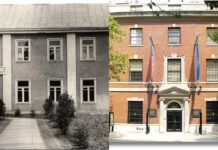It was disturbing, but not that surprising, to learn the Vatican recently allowed a Nativity scene on its premises depicting a “Palestinian Jesus.” This falsified myth has been around for decades and always seems to show up in some symbolic form around the Christmas season when the world marks the birth of Jesus in Bethlehem. What is surprising, however, is the Vatican’s subsequent decision to remove the controversial crèche, which is a serious setback for the Palestinian cause and may mark a turning point for its wider rejection as a devious Palestinian propaganda tool.
The provocative Nativity display was designed by Palestinian Arab Christians from Bethlehem and featured an infant Jesus resting on a black-and-white keffiyeh—an unmistakable symbol of Palestinian nationalism. Apparently, the handlers of Pope Francis deemed it important to show sympathy for Palestinian suffering after more than a year of war in the land, and thus he was photographed officially inaugurating the display. This is a moment the papacy now seems to regret, as it has reportedly been shelved following a backlash from offended Christians and Jews worldwide.
This crèche not only denigrated Jewish heritage, it also undermined core tenets of the Christian faith. It would have been theological malpractice for the Holy See to allow this display to remain, for if Jesus was a Palestinian Arab, then he would not have qualified to be the Christ, the promised Messiah. Both the Hebrew and Christian Scriptures are clear that he would be the “Son of David,” springing forth from the “root of Jesse,” the least clan of the tribe of Judah. The New Testament affirms he was born in the “City of David,” where the wise men came seeking him who was born “King of the Jews,” not the rais of Ramallah.
While this episode may be over for now, the manufactured lie of a “Palestinian Jesus” must be discarded completely, as it is a deceptive narrative on par with the Aryan Jesus in terms of its malicious intent towards the Jewish people.

While most Jews in Israel are reticent to claim Jesus as one of their own, the Palestinians are a different story. Most are proud that he was born in their “country,” and even Muslim crowds flock to Manger Square in December to celebrate Christmas. But the Jesus they identify with has been deliberately stripped of his Jewish heritage and his redemptive role. He is a “Palestinian Jesus” who rather serves an important political role in building support for their nationalist cause.
It was local Arab Christians who first began exploiting the fabricated symbolism of a Palestinian Jesus as one of their main contributions to Palestinian nationalism. The tenured Columbia University professor Edward Said, in particular, popularized its use during his time as a close adviser and speechwriter for Palestinian Liberation Organization chief Yasser Arafat. By the time of his 1988 BBC documentary film “My Beautiful Old House,” the late Said had perfected this unsavory trope when describing the Palestinians as enduring “this endless Calvary … this constant crucifixion” at the hands of the Jews.
Arafat readily embraced the myth, presenting the historic Jesus as the “first Palestinian revolutionary” who came to fight Roman oppression just as Palestinians today fight against Israeli occupation. At a news conference at the United Nations in 1983, Arafat called Jesus “the first Palestinian fedayeen who carried his sword.” When Arafat triumphantly took control of Bethlehem in December 1995, he told a throng gathered in Manger Square that he was there to liberate “the birthplace of our Lord the Messiah … the city of the Palestinian Jesus!”
This fabrication of a Palestinian Jesus has been a core part of the lexicon of Palestinian nationalism since at least the 1960s, as evidenced by news archive photos from a PLO press conference held by Arafat in Amman in June 1970. Over his shoulder hangs a poster of a gaunt, near-naked Palestinian nailed to a Star of David. The message is clear: The Palestinians are suffering at the hands of the Jews, just like Jesus did.
This is the most odious and disgraceful facet of the Palestinian Jesus narrative, as its Christian and Muslim adherents both deliberately conjure up classic Christian antisemitic motifs by portraying the Palestinian people as the “Body of Christ” that is still being “crucified” by the Jews.
So, there is nothing innocent about the Palestinian Jesus, even when he is portrayed as a babe lying on a keffiyeh in a manger scene. This lie has such ignoble origins, malicious motives and fraudulent ends that it cannot be tolerated at any time or in any place.
Thus, the Vatican did the right thing in taking down the offensive Nativity display, and hopefully, it will cause others to think twice before they engage in such antisemitic messaging.


























